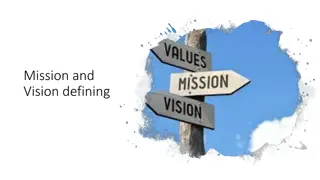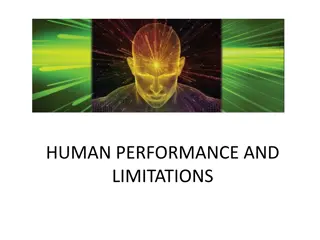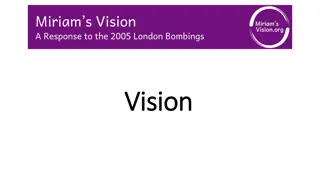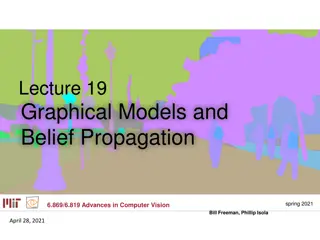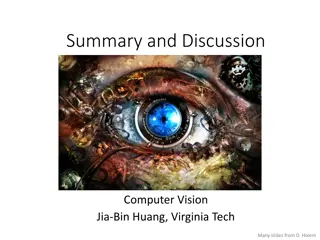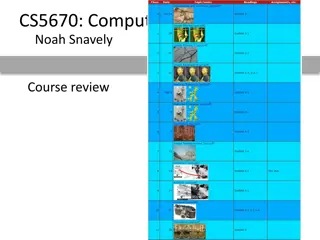Understanding Night Vision Technology and Its Applications
Night vision technology enables vision in the dark, initially developed for military use. This seminar explores the types of night vision, working principles, devices, generations, applications, and conclusions. It delves into biological and technical night vision, highlighting the ways they operate to amplify light for enhanced visibility. By utilizing image intensifiers and thermal imaging, night vision devices can detect objects based on their temperature patterns, ultimately aiding in various applications beyond military settings.
Download Presentation

Please find below an Image/Link to download the presentation.
The content on the website is provided AS IS for your information and personal use only. It may not be sold, licensed, or shared on other websites without obtaining consent from the author. Download presentation by click this link. If you encounter any issues during the download, it is possible that the publisher has removed the file from their server.
E N D
Presentation Transcript
www.studymafia.org Seminar On Night Vision Technology Submitted To: www.studymafia.org www.studymafia.org Submitted By:
CONTENTS Introduction Types of Night Vision Working of Technical Night Vision Night Vision Devices Generations Applications Conclusion Reference
INTRODUCTION Night vision technology, literally allows one to see in the dark. It is originally developed for military use . Humans have poor night vision compared to many other animals. With the proper night-vision equipment, we can see a person standing over 200 yards (183 m) away on a moonless, cloudy night.
TYPES OF NIGHT VISION It is broadly classified into two types Biological Night Vision Molecules in the rods of the eye undergo a change in shape as light. Molecules in the human rods is insensitive to the light. Technical Night Vision Image intensifier Thermal imaging
WORKING OF TECHNICAL NIGHT VISION Technical Night vision can work in two very different ways Image Intensifier Night vision amplifies light to achieve better vision . A conventional lens, captures ambient light. The gathered light is sent to the image-intensifier tube. The light energy released electron from the cathode and accelerated.
Contd These electrons enter micro channel plate and bounce off and generate more electron. Thousands of other electrons to be released in each channel. Original electrons collide with the channel,exciting atoms and causing other electrons. New electrons collide with other atoms, creating a chain.
Contd In image-intensifier tube, the electrons hit a screen. The energy of the electrons release photons and create green image on the screen. The green phosphor image is viewed through another lens. Sources: http://www.nightvision.com Fig1:- Image intensifier process
Contd Thermal Imaging All objects emit infrared energy as a function of their temperature. A lens focuses the infrared light. The focused light is scanned and create temperature pattern. The pattern created is translated into electric impulses.
Contd The impulses are sent to a circuit board that translates the information into data for the display. The signal-processing unit sends the information to the is play, and appears as various colors. Thermal images are black and white in nature.
Contd Fig2:-Thermal imaging process Sources: http://www.nightvision.com
NIGHT VISION DEVICES Night vision devices are basically divided into three categories SCOPES They are monocular normally handheld or mounted on a weapon. GOGGLES They are binocular and worn on the head. CAMERAS Used for transmission or recording of images mostly if the location is fixed. Fig3:- Night vision devices Sources: http://www.nightvision.com
GENERATIONS Generation 0 The earliest (1950's) night vision products were based on image conversion, rather than intensification. Generation 1 Vacuum Tube Technology Full Moon Operation Amplification: 1,000 Operating Life: 2,000 Hours
Contd Fig4:- Generations1 Night vision Sources: http://www.nightvision.com
Contd Generation 2 First Micro channel Plate Application One-Quarter Moon Operation Amplification: 20,000 Operating Life: 2,500 Hours Generation3 Improved Micro channel Plate & Photocathode Starlight Operation Amplification: 40,000 Operating Life: 10,000 Hour
Contd Fig5:- Generations2 Night vision device Sources: http://www.nightvision.com
APPLICATIONS Military Hunting Wildlife observation Security Hidden-object detection
ADVANTAGES No particular skill required Accidents cases reduction Compact system 3x range visual
DISADVANTAGES The only disadvantage is that the Initial cost too high.
CONCLUSIONS Today in the 21st century we have come a long way in the development of night vision technology, from the early 1940 s. Night vision devices are basically designed for utmost defensive purposes but the application within the scientific or the civilian range is often prohibited by law. In present scenario the applications of night vision technology is very essential to combat terrorism which is a major problem being faced by mankind.
REFERENCES http://www.google.co.in http://www.photonis.com/nightvision/products/supergen/su pergen_specifications http://www.irinfo.org/articles/03_01_2007_grossman.html Www.Wikipedia.Org Studymafia.org Www.Morovision.Com/How_thermal_imaging_works.Htm En.Wikipedia.Org/Wiki/Night_vision




